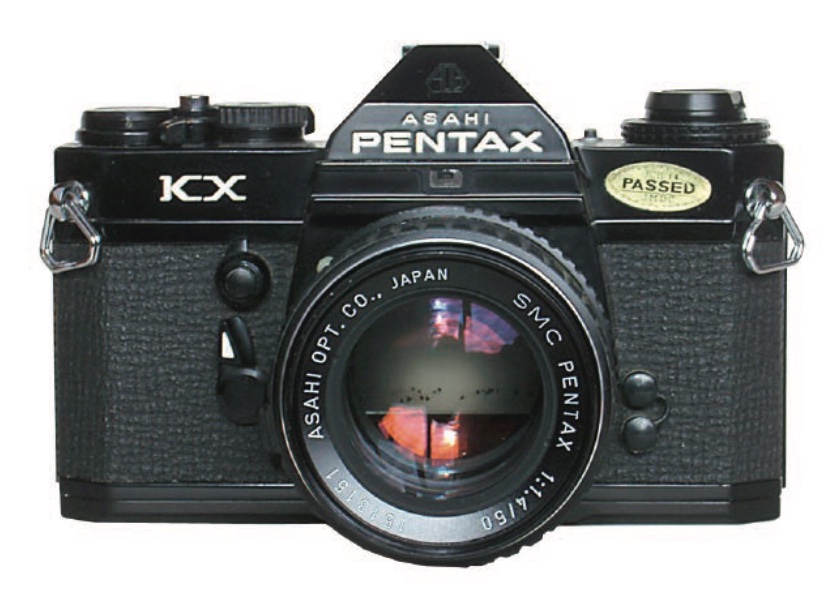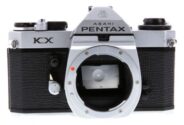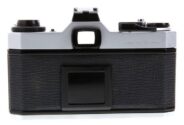Asahi Pentax KX
35mm MF film SLR camera
Specification
| Production details: | |
| Announced: | June 1975 |
| System: | ● Pentax K (1975) |
| Format: | |
| Maximum format: | 35mm full frame |
| Film type: | 135 cartridge-loaded film |
| Mount and Flange focal distance: | Pentax K [45.5mm] |
| Shutter: | |
| Type: | Focal-plane |
| Model: | Mechanical |
| Speeds: | 1 - 1/1000 + B |
| Exposure: | |
| Exposure metering: | Through-the-lens (TTL), open-aperture |
| Exposure modes: | Manual |
| Physical characteristics: | |
| Weight: | 631g |
| Dimensions: | 143x91.4x52.5mm |
Manufacturer description #1
The incredible Pentax KX: think of it as five great cameras in one.
...because it takes that many of the world's finest cameras to produce the combination of top features found in a single KX.
You can check this out yourself and if you're beginning to think the recent technological advances in 35mm are something you can't live without much longer... it would be rewarding research.
Let's take a look at that claim...
A perfected bayonet-mount
You can get a bayonet-mount on any number of fine 35mm SLRs. But only one other fine camera has raised locator nodes like the KX. You can change lenses without looking ...even in the dark. And fast ... the Pentax bayonet-mount locks lenses in place in less than a quarter turn.
Metering a pro would love
The KX's metering is center-weighted, with very fast silicon photo diodes. There are four other cameras that have silicon photo diodes. But not one of them is in combination with the perfected bayonet-mount of the KX.
Full disclosure viewfinder
There are three cameras that show you both f/stop and shutter speed in their viewfinders. But only the KX gives you a single aperture number, plus match-needle metering superimposed over the shutter speed scale for faster, easier operation.
Coating on every lens surface
Every lens surface on the KX (like all Pentax cameras) is a super-multi-coated. No other fine camera pays such attention to this detail.
Silver-coated pentaprism
The Pentax KX has a silver-coated pentaorism for brighter viewing. One other fine camera also has this feature but this camera does not show you aperture in the viewfinder.
And even more
Even if you could jam those five great cameras into one ...it would still fall short of a KX. Balance, feel, responsiveness, elegance and yes ...a fair price. They all get nicely together in one superb unit ...KX.
The Pentax K-series (there are three cameras) is a total system with over 200 matched accessories available right now. What's more, Pentax also has available a low-cost K-adapter that lets you use any existing Pentax screw-mount lens with your new K-series camera.
The Pentax KX: It's just like having five great cameras in one.
Manufacturer description #2
TYPE: 35mm SLR with built-in through-the-lens light meter
FILM AND PICTURE SIZE: 35mm film. 24mm x 36mm
SHUTTER: Horizontal run, focal plane shutter of rubberized silk curtains. Speeds: B, 1 to 1/1000 sec. Shutter button lock provided
SELF-TIMER: Built-in self-timer with interrupt function. Releases shutter in 5-13 sec.
VIEWFINDER: Pentaprism finder with cross-microprism or split-image focusing screen. Aperture setting on lens visible in viewfinder. Shutter speed setting indicated by blue needle. 0.88x magnification with 50mm lenses (life-size with 55mm lens). Dioptry -0.8. 93% field of view
FOCUSING: Turn focusing ring until viewfinder image comes into focus
REFLEX MIRROR: Instant-return type with mirror lock-up device and special shock absorbers for minimum vibration
LENS MOUNT: Pentax bayonet mount
FILM ADVANCE: Ratchet-type rapid-wind lever. 20° pre-advance and 160° advance angle. "Cocked" indicator alongside shutter release button
EXPOSURE COUNTER: Automatic re-set
FILM REWIND: Rapid-rewind crank for speedy film take-up
FLASH SYNCHRONIZATION: X contact hot shoe for cordless flash connection. FP + X contacts for conventional flash cord connection. X synchronization at 1/60 sec.
EXPOSURE METER: Silicon-Photo-Diode meter measures central portion of ground glass at full aperture. Couples directly to shutter, aperture and film speed settings. Match needles for correct exposure. Film speed from 8 to 6400 ASA. Powered by two 1.5V silver oxide batteries
MEMO HOLDER: Square metal sleeve for holding type/speed tab from top of film box
Manufacturer description #3
The KX utilizes a through-the-lens, open aperture, match-needle, metering system which offers the incredible accuracy and sensitivity of silicon photo diodes. Furthermore, the viewfinder of the KX tells all: Set the desired shutter speed and the transparent blue indicator needle moves to the selected position, serving as a reminder; next, match needles for correct exposure by rotating the aperture ring and the small window above the viewfinder informs the photographer of the position of the aperture ring. Thus, either shutter speed or aperture can be adjusted without removing the camera from one's eye.
- Rapid-wind film advance lever with plastic thumb guard for effortless consecutive shooting;
- Memo holder on back cover holds tab from film box showing film type and ASA;
- Highly-reputed focal-plane shutter with speeds ranging from 1/1000 sec. to 1 sec. A shutter button lock alowing time exposures is built onto the camera;
- Full-information viewfinder indicates the aperture setting as actually shown on the aperture ring;
- Depth-of-field preview button assures easy confirmation of depth of field. Mirror lock-up lever is tucked up high, out of the way;
- Body available in chrome or black finish;
- The KX has been designed to save power in its Integrated Circuit and employs a through-the-lens center-weighted metering system.
Similar cameras (26)
35mm full frame • Manual focus • Film • Singe-lens reflex • Pentax K mount
| Model | Shutter | Metering | Modes | Year |
|---|---|---|---|---|
| Almaz-103 | M, 1/1000 | -- | M | 1980 |
| Ricoh KR-10 aka Ricoh CR-10 aka Ricoh XR-1000S |
E, 1/1000 | TTL • OA | AM | 1980 |
| Ricoh KR-10SE | E, 1/1000 | TTL • OA | AM | 1980 |
| Ricoh KR-5SV | M, 1/2000 | TTL • OA | M | 2000 |
| Ricoh XR Solar | M, 1/2000 | TTL • OA | M | 1994 |
| Ricoh XR-1 | M, 1/1000 | TTL • OA | M | 1977 |
| Ricoh XR-1S | M, 1/1000 | TTL • OA | M | 1979 |
| Ricoh XR-2 | E, 1/1000 | TTL • OA | AM | 1977 |
| Ricoh XR-2000 aka Ricoh KR-10 Super |
E, 1/1000 | TTL • OA | AM | 1982 |
| Ricoh XR-2S | E, 1/1000 | TTL • OA | AM | 1979 |
| Ricoh XR-8 aka Ricoh KR-5 Super II |
M, 1/2000 | TTL • OA | M | 1993 |
| Ricoh XR-8 Super aka Ricoh KR-5 III |
M, 1/2000 | TTL • OA | M | 1994 |
| Ricoh XR-F | E, 1/1000 | TTL • OA | AM | 1983 |
| Ricoh XR-S | E, 1/1000 | TTL • OA | AM | 1981 |
| Ricoh XR5 aka Ricoh CR-5 aka Ricoh KR-5 Super |
M, 1/1000 | TTL • OA | M | 1980 |
| Ricoh XR500 aka Ricoh KR-5 |
M, 1/500 | TTL • OA | M | 1978 |
| Ricoh XR500 auto | E, 1/1000 | TTL • OA | AM | 1982 |
| Ricoh XR6 | E, 1/1000 | TTL • OA | AM | 1981 |
| Ricoh XR7 | E, 1/1000 | TTL • OA | AM | 1982 |
| Zenit-122K | M, 1/500 | TTL • WA | M | 1990 |
| Zenit-14 | E, 1/1000 | TTL • OA | M | 1987 |
| Zenit-212k | M, 1/500 | TTL • WA | M | 1995 |
| Zenit-AM / AM2 / AM3 | E, 1/1000 | TTL • OA | A | 1989 |
| Zenit-APK | E, 1/2000 | TTL • OA | AM | 1992 |
| Zenit-Avtomat | E, 1/1000 | TTL • OA | A | 1985 |
| Zenit-km | E, 1/2000 | TTL • OA | AM | 2001 |
Table of contents
Clickable
Pentax K system cameras
Clickable
- Asahi Pentax K1000
- Asahi Pentax K1000 SE
- Asahi Pentax K2
- Asahi Pentax K2 DMD
- Asahi Pentax KM
- Asahi Pentax KX
- Asahi Pentax ME
- Asahi Pentax MX
- Pentax *ist
- Pentax A3
- Pentax K-1
- Pentax K-1 Mark II
- Pentax LX
- Pentax ME F
- Pentax ME SE
- Pentax ME super
- Pentax MG
- Pentax MV
- Pentax MV1
- Pentax MZ-10
- Pentax MZ-3
- Pentax MZ-30
- Pentax MZ-5
- Pentax MZ-50
- Pentax MZ-5n
- Pentax MZ-6
- Pentax MZ-60
- Pentax MZ-7
- Pentax MZ-M
- Pentax MZ-S
- Pentax P30
- Pentax P30n
- Pentax P30t
- Pentax P50
- Pentax program A
- Pentax SF7
- Pentax SFX
- Pentax SFXn
- Pentax super A
- Pentax Z-1
- Pentax Z-10
- Pentax Z-1P
- Pentax Z-20
- Pentax Z-5
- Pentax Z-50
- Pentax Z-50P
- Pentax Z-5P
- Pentax Z-70


